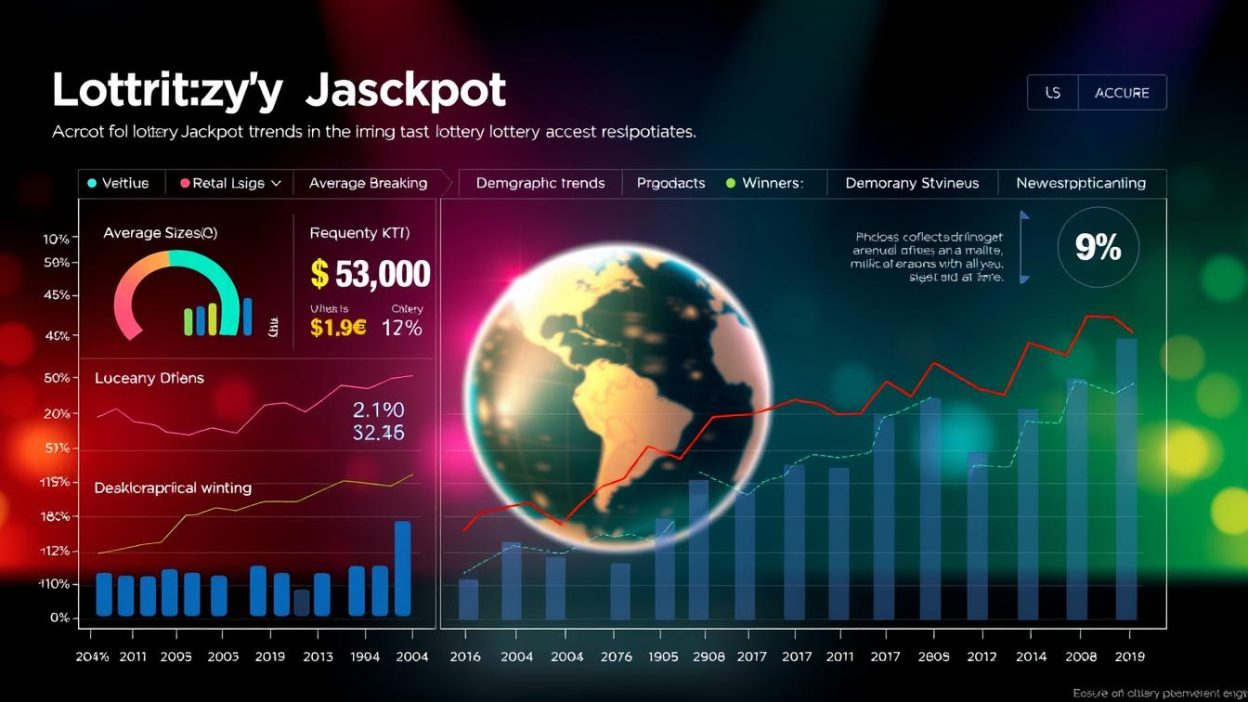Lottery Jackpot Trends: Our Expert Analysis
The allure of life-changing prizes has always captivated millions. Recent years, however, have seen unprecedented growth in these grand prizes. For instance, the $2.04 billion Powerball win in 2022 shattered previous records, drawing nationwide attention.

Sales figures tell a compelling story. In 2022 alone, total revenue soared to $97.8 billion, reflecting a mix of hopeful participants and strategic marketing. States like California and Texas led in ticket purchases, showcasing regional enthusiasm.
Behind the excitement lies a delicate balance. While massive payouts spark dreams, the odds of claiming the top prize remain staggeringly low. This contrast shapes public behavior, driving both surges in sales during peak periods and quieter lulls.
Our analysis explores how these patterns evolved over time. We’ll uncover what rising prize amounts mean for participation and their broader economic effects. From state-level data to winner stories, we aim to reveal the full picture.
Understanding the Evolution of Lottery Sales
From humble starts to billion-dollar revenues, state games have transformed how Americans try their luck. In 2022, players spent $97.8 billion on tickets—enough to cover $392 for every person in the U.S. This growth didn’t happen overnight. Early state-run draws focused on small prizes, but modern games like Mega Millions shifted the focus to life-altering sums.
| State | 2022 Sales (Billions) | Per Capita Spend |
|---|---|---|
| New York | $10.3 | $514 |
| California | $8.7 | $223 |
| Florida | $7.9 | $363 |
| Texas | $6.2 | $208 |
Technology reshaped accessibility. Mobile apps and online purchases now account for 27% of sales, up from 9% in 2018. Retailers still play a role, but convenience drives today’s buyers. Surveys show half of adults participate yearly, often drawn by prize pools exceeding $1 billion.
Payout ratios also evolved. Modern games return 60-70% of revenue as prizes, compared to 50% in the 1990s. This shift keeps players engaged, even as odds remain steep—1 in 302 million for Mega Millions. Next, we’ll explore how individual states tailor strategies to boost participation.
Examining State-Specific Lottery Performances
State boundaries shape how Americans engage with games of chance. New York leads the pack, generating $10.3 billion in 2022 sales—over $500 per resident. California and Texas follow closely, though their per-person spending differs sharply due to population size.

Massachusetts offers a unique case. Despite smaller sales numbers, its per-capita prize returns outpace larger states. Why? Its location draws players from New Hampshire and Rhode Island, especially when Mega Millions jackpots climb above $1 billion.
| State | 2022 Sales | Per Capita | Neighbor Influence |
|---|---|---|---|
| New York | $10.3B | $514 | Low |
| Massachusetts | $5.6B | $798 | High |
| Texas | $6.2B | $208 | Medium |
Urban density plays a key role. Cities like Los Angeles and Houston see higher ticket purchases during evening commutes. Rural areas, however, often wait for nine-figure prizes before joining the rush.
Economic factors also matter. States with higher disposable incomes, like New Jersey, show steadier participation. Meanwhile, regions facing financial strain tend to spike when Mega Millions numbers hit record highs.
In-Depth Analysis of lottery jackpot trends
What drives millions to chase billion-dollar dreams each week? The 2022 Powerball drawing offers clues. Its $2.04 billion grand prize—the largest ever—sparked a 283% sales surge compared to typical weeks. This pattern repeats whenever prizes cross the $1 billion threshold.
Mega Millions shows similar momentum. Since 2018, its average top prize grew 47%, reaching $456 million per drawing. Yet odds remain astronomical—1 in 302 million for the top tier. Despite this, 65% of adults admit buying tickets when headlines tout “historic” amounts.
| Game | Largest Prize | Year | Ticket Sales Spike |
|---|---|---|---|
| Powerball | $2.04B | 2022 | +317% |
| Mega Millions | $1.58B | 2023 | +291% |
| Powerball | $1.59B | 2016 | +228% |
Prize structures now favor bigger payouts over frequency. In 2015, only 12% of Mega Millions drawings exceeded $500 million. By 2023, that figure jumped to 34%. This shift keeps regular players engaged while attracting casual buyers during peak cycles.
Winners’ choices also reflect changing attitudes. Over 60% now opt for lump-sum payments rather than annuities, seeking immediate financial flexibility. Yet most grand prize recipients still face long-term challenges—a reality often overshadowed by initial excitement.
Player Behavior and Ticket Purchasing Patterns
Human psychology drives fascinating shifts in how people engage with games of chance. When Mega Millions prizes climb past $500 million, ticket sales often triple within days. A 2023 survey found 73% of adults buy tickets solely during these peak periods, chasing the fleeting chance at fortune.

Regular participants tell a different story. Only 15% purchase weekly, often spending $20 or more per drawing. These dedicated players account for nearly 40% of total sales, creating a stable revenue base between jackpot surges.
What explains the rush during massive prizes? The “fear of missing out” intensifies as headlines multiply. Even with odds of 1 in 302 million, many buyers purchase 5-10 tickets when prizes break records—a 2022 study showed orders doubling when jackpots cross $1 billion.
These patterns create cyclical momentum. Larger prizes draw casual players, which fuels faster prize growth. This feedback loop explains why nine-figure payouts now occur 3x more frequently than a decade ago, reshaping how states design games.
Economic Impact and State Revenue Allocation
State budgets often rely on surprising income streams to fund critical services. In 2022, ticket sales generated $97.8 billion nationwide—money that supports schools, roads, and public programs. For some states, these funds make up 7% of total tax income, rivaling traditional revenue sources.
Where does the money go? Over 30 states direct proceeds to education. Georgia, for example, uses $1.3 billion annually for college scholarships. Others prioritize infrastructure, like Pennsylvania’s investments in senior transportation. These choices directly affect local communities.
| State | Annual Revenue | Key Allocation |
|---|---|---|
| California | $2.1B | Public Schools |
| New York | $3.5B | Local Governments |
| Florida | $1.9B | Environmental Projects |
Balancing payouts and public benefits remains challenging. Mega Millions returns 65% of sales as prizes but leaves 35% for administrative costs and state programs. During economic downturns, participation often rises as people seek financial hope, boosting budgets when other taxes decline.
Policy changes also shape outcomes. States increasing prize percentages saw 12% higher sales last year. However, critics argue this prioritizes entertainment over essential funding. The debate continues as governments weigh immediate revenue against long-term social impacts.
The Social and Psychological Effects of Winning
Sudden wealth transforms lives in ways few anticipate. Studies reveal 70% of major prize recipients face financial ruin within five years. The initial euphoria often fades as reality sets in—managing millions requires skills most people lack.

Stress peaks when winners navigate taxes, investments, and requests from friends. Nearly 1 in 3 report strained family ties after claiming prizes. Legal battles over winnings account for 14% of court cases involving windfalls.
| Prize Tier | Bankruptcy Rate | Family Conflict Reported | Continue Playing |
|---|---|---|---|
| $1M-$5M | 42% | 29% | 68% |
| $5M-$50M | 71% | 53% | 57% |
| $50M+ | 89% | 67% | 44% |
Why do many keep buying tickets after big wins? Psychologists note the “habit loop”—the thrill of anticipation becomes addictive. Mega Millions participants often double their spending post-win, chasing that fleeting high again.
Long-term effects reshape entire communities. Schools near recent winners see 23% more student absences as families speculate about wealth. Yet most recipients say they’d take the chance again, despite the turmoil it brings.
Insights from Notable Jackpot Wins and Unclaimed Prizes
Mega Millions and Powerball winners often become overnight legends. The 2022 $2.04 billion Powerball victory set records, with the California ticket holder choosing lump-sum winnings over annual payments. This mirrors a growing preference—76% of recent winners take immediate cash to pursue investments or charitable goals.
Not every story ends with celebration. A 2021 Georgia Powerball ticket worth $1 million expired unsigned. Such cases leave money in state coffers—over $4 billion in unclaimed prizes since 2010. States typically reallocate these funds to education or infrastructure projects within 180 days.
| Prize | Location | Expiration | State Use |
|---|---|---|---|
| $1.6M Powerball | Indiana | 2020 | Road repairs |
| $77M Mega Millions | New York | 2019 | School grants |
| $250K Powerball | Texas | 2023 | Wildlife conservation |
Why do people forget life-changing tickets? Busy schedules and misplaced stubs top the list. Retailers report 23% of potential winners never check their numbers. Some simply don’t believe their odds—a psychological barrier states combat through awareness campaigns.
These unclaimed funds create unexpected benefits. California’s public schools gained $156 million from expired tickets last year. While individual losses sting, collective gains demonstrate how luck—even when missed—still shapes communities.
Conclusion
Our exploration of America’s gaming landscape reveals enduring patterns. Mega Millions and state-run lotteries generate billions annually, funding vital services while sparking dreams. Yet the odds of hitting jackpots—often 1 in 300 million—remain a sobering reality.
Winners’ stories highlight both opportunity and challenge. While immediate cash options attract many, studies show most face long-term financial strain. This duality underscores why informed participation matters: chasing winnings requires understanding the slim chance of success when selecting numbers.
State strategies in lotteries continue evolving. Higher prize allocations and digital access drive engagement, particularly during record-breaking jackpot cycles. However, balancing public benefit with responsible play remains critical for sustainable growth.
As we reflect on these insights, one truth emerges: hope and statistics will always coexist in this space. Whether you choose to play or observe, recognizing this dynamic offers clarity amidst the excitement.





